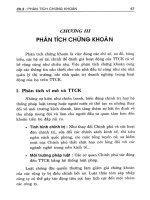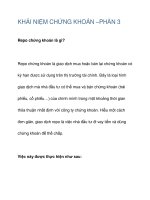Preparing Financial Statements phần 3 ppt
Bạn đang xem bản rút gọn của tài liệu. Xem và tải ngay bản đầy đủ của tài liệu tại đây (342.04 KB, 10 trang )
13
Study Period 7 continued
Were you awake?
If you've been concentrating, you should be able to answer some key questions.
What is a trial balance?
Why does a trial balance balance?
What type of errors are disclosed by a trial balance?
What items go into the capital account?
Any problems?
Email (accaqueries @bpp.com) fax (020 8740 2293) or phone us (020 8740 2242/2245)
Learning Resource Centre
What do you want to do? How to do it! Reference
Test your knowledge BPP i-Pass *
Session 2: Double entry,
assets and liabilities
Session 7: Incomplete
records and sales tax
Learn interactively BPP i-Learn/BPP Virtual Campus Module 3 and 10 (VAT)
Improve your study skills
BPP's Learning to Learn
Accountancy book *
* Included within your Home Study course
If you want any of these products, visit:
www.bpp.com/acca
Common Pitfall
• Understating the importance of this chapter – it is essential reading
14
Study Period 8
The cost of goods sold, accruals and prepayments
Priority = High
Date due:
Exam Guidance
Adjustments to the trial balance for items such as inventory, accruals and prepayments feature
regularly in accounts preparation questions.
Guidance through the Study Text
These topics are covered in Chapter 11 The cost of goods sold, accruals and prepayments.
Section Approach Essential points
1 Cost of goods sold Work through carefully. Adjustments for closing inventory
2
Accruals and
prepayments
Pay particular attention to this ,
as it features in every exam.
Accruals are expenses not yet paid
for and so are a liability in the
balance sheet
Prepayments are expenses paid for a
future trading period and so are an
asset in the balance sheet
Try Question 14 in the Exam Question Bank of your Study Text
Exam focus point
There are usually a number of MCQs on accruals and prepayments.
15
Study Period 8 continued
Were you awake?
If you've been concentrating, you should be able to answer some key questions.
Inventory adjustment, accruals and prepayments are examples of which concept?
Define an accrual.
What is the double entry for prepayments?
How do you calculate the cost of goods sold, including adjustments for opening and closing
inventory?
Any problems?
Email (accaqueries @bpp.com) fax (020 8740 2293) or phone us (020 8740 2242/2245)
Learning Resource Centre
What do you want to do? How to do it! Reference
Test your knowledge BPP i-Pass *
Session 3: Balance sheet
provisions
Learn interactively BPP i-Learn/BPP Virtual Campus Module 4 Part 1
Improve your study skills
BPP's Learning to Learn
Accountancy book *
* Included within your Home Study course
If you want any of these products, visit:
www.bpp.com/acca
Common Pitfalls
• Ignoring accruals and prepayments because the concepts are difficult – learn
them now rather than later
• Using the date of payment to calculate usage, it is the period to which the
invoice relates that is important
16
Study Period 9
Bad debts and allowances
Priority = High Examined: 6/05
Date due:
Exam Guidance
These topics are unlikely to be the basis for an entire question. However, they could be
examined in control accounts (Study Period 14) or preparation of final accounts.
Guidance through the Study Text
These topics are covered in Chapter 12 Bad debts and provisions.
Section Approach Essential points
1 Bad debts
Pay particular attention to this, as
it is normally examined.
Definition of a bad debt
2
Allowances for
doubtful debts
Read through this very carefully.
How to calculate the increase or
decrease in a general allowance
3
Accounting for
bad and
doubtful debts
Work through this carefully.
Make sure you know the accounting
treatments.
Try Question 16 in the Exam Question Bank of your Study Text
Exam focus point
Calculating the movement on the allowance for receivables account is a popular MCQ, which
featured in the June 2005 exam.
Note that ACCA no longer refer to ‘doubtful debts’. The balance sheet account is now referred to
as the “allowance for receivables”.
17
Study Period 9 continued
Were you awake?
If you've been concentrating, you should be able to answer some key questions.
What is a bad debt?
How do you account for a recovery of a debt previously written off as bad?
What is the accounting treatment of a decrease in a general allowance for receivables?
How do you account for a specific allowance for receivables?
Any problems?
Email (accaqueries @bpp.com) fax (020 8740 2293) or phone us (020 8740 2242/2245)
Learning Resource Centre
What do you want to do? How to do it! Reference
Test your knowledge BPP i-Pass *
Session 3: Balance sheet
provisions
Learn interactively BPP i-Learn/BPP Virtual Campus Module 4 Part 2
Improve your study skills
BPP's Learning to Learn
Accountancy book *
* Included within your Home Study course
If you want any of these products, visit:
www.bpp.com/acca
Common Pitfall
• Calculating the general allowance on the debtors balance before dealing with
bad debts and specific allowances – the order of calculation is crucial
18
Study Period 10
Accounting for inventories
Priority = High Examined: 6/05
Date due:
Exam Guidance
You must understand the importance of inventory valuation calculations, as well as being able
to use the different methods.
Guidance through the Study Text
These topics are covered in Chapter 13 Accounting for inventories.
Section Approach Essential points
1
Accounting for opening
and closing inventories
Read through carefully.
Learn the accounting entries
for inventory
2 Counting inventories Skim read this section.
3 Valuing inventories Pay particular attention to this.
Learn the different valuation
methods
4 IAS 2 Inventories Read through this carefully.
Learn the rule that inventory is
valued at the lower of cost and
NRV
Try Question 17 in the Exam Question Bank of your Study Text.
Exam focus point
The June 2005 paper had two MCQs on inventory.
19
Study Period 10 continued
Were you awake?
If you've been concentrating, you should be able to answer some key questions.
What are the ledger account entries for opening and closing inventory?
What is the effect of the FIFO, LIFO and weighted average methods on profit?
(But remember that LIFO is no longer allowed)
What is the basic concept behind IAS 2?
What is the difference between continuous and period end inventory counting?
Any problems?
Email (accaqueries @bpp.com) fax (020 8740 2293) or phone us (020 8740 2242/2245)
Learning Resource Centre
What do you want to do? How to do it! Reference
Test your knowledge BPP i-Pass *
Session 5: Inventory
valuations
Learn interactively BPP i-Learn/BPP Virtual Campus Module 6
Improve your study skills
BPP's Learning to Learn
Accountancy book *
* Included within your Home Study course
If you want any of these products, visit:
www.bpp.com/acca
Common Pitfall
• Not understanding the principles behind IAS 2 – you may be asked to discuss
these
20
Study Period 11
Non-current assets and depreciation
Priority = High Examined: 6/05
Date due:
Exam Guidance
Depreciation is a key area that can form an entire question or part of an accounts preparation
question. You must know and understand the basic rules of IAS 16. Discursive questions may
be set, requiring the explanation of the purpose of depreciation and the factors that need to be
taken into account in assessing the amount of depreciation required each year.
Guidance through the Study Text
These topics are covered in Chapter 14 Non-current assets and depreciation.
Section Approach Essential points
1
Depreciation
accounting
Work through this carefully.
Definition and purpose of
depreciation
2
Depreciation: the
mechanics
Read through very carefully.
Learn the different ways of
calculating depreciation
3
Revaluation of non-
current assets
Read this carefully.
Learn how to set up the
revaluation reserve
4
Non-current asset
disposals
Pay particular attention to this.
Calculation of the profit or loss
on disposal
5
IAS 16 Property, plant
and equipment
Skim read this section.
6 The asset register Skim read this section.
7
Preparation of final
accounts for a sole
trader
Work through this carefully.
Make sure you can reproduce
the answer to Question 5
Try Question 18 in the Exam Question Bank of your Study Text
Exam focus point
The June 2005 exam had an MCQ on property revaluation and a balance sheet preparation
question requiring adjustments to non-current assets.
21
Study Period 11 continued
Were you awake?
If you've been concentrating, you should be able to answer some key questions.
What is the definition of non-current assets?
Define depreciation.
What are the accounting entries for a disposal of non-current assets?
How do you calculate depreciation on the straight line basis?
Any problems?
Email (accaqueries @bpp.com) fax (020 8740 2293) or phone us (020 8740 2242/2245)
Learning Resource Centre
What do you want to do? How to do it! Reference
Test your knowledge BPP i-Pass *
Session 3: Balance sheet
provisions
Learn interactively BPP i-Learn/BPP Virtual Campus Module 4
Improve your study skills
BPP's Learning to Learn
Accountancy book *
* Included within your Home Study course
If you want any of these products, visit:
www.bpp.com/acca
Common Pitfalls
• Deducting residual value when performing the reducing balance method of
depreciation. Remember, when using reducing balance depreciation ignore the
residual value and the useful life. Simply apply the depreciation % rate to the
NBV.
• Calculating the number of months incorrectly if an asset is acquired during the
year – you may need to pro-rate depreciation charges in this case
22
Study Period 12
Progress Test 1
Priority = High
Date due:
In order to reinforce what you have learnt in Study Periods 1 – 11, answer the following multiple
choice questions without referring to your Study Text or notes. You should then revise any areas
with which you had difficulty.
1 The purpose of a balance sheet is to show:
A A clear and definite estimate of what a business is really worth
B The amount the business could be sold for in liquidation
C The amount the business could be sold for as a going concern
D The assets of the business and the claims against those assets
2 A debit entry to the sales account could represent:
A Cash sales
B Credit sales or the correction of an error
C Bad debts written off
D The correction of an error or goods returned
3 Which of the following statements is incorrect?
A If the trial balance does not balance an error must have been made
B The closing inventory balance is included in the trial balance
C Proprietors withdrawals are shown on the trial balance
D The opening inventory balance is included in the trial balance









